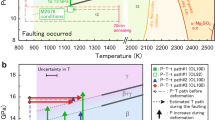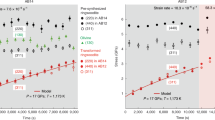Abstract
The mineral akimotoite, ilmenite-structured MgSiO3, exists at the bottom of the Earth’s mantle transition zone and within the uppermost lower mantle, especially under low-temperature conditions1. Akimotoite is thought to be a major constituent of the harzburgite layer of subducting slabs, and the most anisotropic mineral in the mantle transition zone2,3,4. It has been predicted that if akimotoite crystals are preferentially oriented by plastic deformation, a cold subducted slab would be extremely anisotropic5. However, there have been no studies of crystallographic preferred orientations and very few reports of plastic deformation experiments for MgSiO3 ilmenite. Here we present plastic deformation experiments on polycrystalline akimotoite, which were conducted at confining pressures of 20–22 GPa and temperatures of 1,000–1,300 °C. We found a change in crystallographic preferred orientation pattern of akimotoite with temperature, where the c-axis maximum parallel to the compression direction develops at high temperature, whereas the c axes are preferentially oriented parallel to the shear direction or perpendicular to the compression direction at lower temperature. The previously reported difference in compressional-wave seismic anisotropy between the northern and southern segments of the Tonga slab at depths of the mantle transition zone6 can conceivably be attributed to the difference in the crystallographic preferred orientation pattern of akimotoite at varying temperature within the slab.
This is a preview of subscription content, access via your institution
Access options
Subscribe to this journal
Receive 51 print issues and online access
$199.00 per year
only $3.90 per issue
Buy this article
- Purchase on Springer Link
- Instant access to full article PDF
Prices may be subject to local taxes which are calculated during checkout
 ,
,  and [0001] directions of akimotoite in all samples.
and [0001] directions of akimotoite in all samples.


Similar content being viewed by others
References
Akaogi, M., Tanaka, A. & Ito, E. Garnet–ilmenite–perovskite transitions in the system Mg4Si4O12–Mg3Al2Si3O12 at high-pressures and high-temperatures: phase equilibria, calorimetry and implications for mantle structure. Phys. Earth Planet. Inter. 132, 303–324 (2002)
Weidner, D. J. & Ito, E. Elasticity of MgSiO3 in the ilmenite phase. Phys. Earth Planet. Inter. 40, 65–70 (1985)
Da Silva, C. R. S., Karki, B. B., Stixrude, L. & Wentzcovitch, R. M. Ab initio study of the elastic behavior of MgSiO3 ilmenite at high-pressure. Geophys. Res. Lett. 26, 943–946 (1999)
Zhang, Y., Zhao, D. & Matsui, M. Anisotropy of akimotoite: A molecular dynamics study. Phys. Earth Planet. Inter. 151, 309–319 (2005)
Anderson, D. L. Theory of the Earth (Blackwell, 1989)
Vavryčuk, V. Spatially dependent seismic anisotropy in the Tonga subduction zone: A possible contributor to the complexity of deep earthquakes. Phys. Earth Planet. Inter. 155, 63–72 (2006)
Randle, V. Microtexture Determination and its Applications 2nd edn (Maney, 2003)
Cordier, P. in Plastic Deformation of Minerals and Rocks (eds Karato, S. I. & Wenk, H. R.) 137–179 (American Mineralogical Society, 2002)
Bascou, J., Raposo, M. I. B., Vauchez, A. & Egydio-Silva, M. Titanohematite lattice-preferred orientation and magnetic anisotropy in high-temperature mylonites. Earth Planet. Sci. Lett. 198, 77–92 (2002)
Lister, G. S. Fabric transitions in plastically deformed quartzites: competition between basal, prism and rhomb systems. Bull. Mineral. 102, 232–241 (1979)
Schmid, S. M. & Casey, M. Complete fabric analysis of some commonly observed quartz c-axis patterns. Am. Geophys. Un. Geophys. Monogr. 36, 263–286 (1986)
Mainprice, D., Bouchez, J.-L., Blumenfeld, P. & Tubia, J. M. Dominant c slip in naturally deformed quartz; implications for dramatic plastic softening at high temperature. Geology 14, 2181–2202 (1986)
Katayama, I. & Karato, S. Effect of temperature on the B- to C-type olivine fabric transition and implication for flow pattern in subduction zones. Phys. Earth Planet. Inter. 157, 33–45 (2006)
Carter, N. L. & Ave’Lallemant, H. G. High temperature flow of dunite and peridotite. Geol. Soc. Am. Bull. 81, 2181–2202 (1970)
Jung, H. & Karato, S.-I. Water-induced fabric transitions in olivine. Science 293, 1460–1463 (2001)
Blacic, J. D. Plastic deformation mechanisms in quartz: The effect of water. Tectonophysics 27, 271–294 (1975)
Mainprice, D. A. FORTRAN program to calculate seismic anisotropy from the lattice preferred orientation of minerals. Comput. Geosci. 16, 385–393 (1990)
Tommasi, A., Mainprice, D., Cordier, P., Thoraval, C. & Couvy, H. Strain-induced seismic anisotropy of wadsleyite polycrystals and flow patterns in the mantle transition zone. J. Geophys. Res. 109 B12406 10.1029/2005JB004168 (2004)
Chen, W.-P. & Brudzinski, M. R. Evidence for a large-scale remnant of subducted lithosphere beneath Fiji. Science 292, 2475–2479 (2001)
Chen, W.-P. & Brudzinski, M. R. Seismic anisotropy in the mantle transition zone beneath Fiji–Tonga. Geophys. Res. Lett. 30 1682 10.1029/2002GL016330 (2003)
Zhao, D. et al. Depth extent of the Lau back-arc spreading center and its relation to subduction processes. Science 278, 254–257 (1997)
Brudzinski, M. R. & Chen, W.-P. A petrologic anomaly accompanying outboard earthquakes beneath Fiji–Tonga: Corresponding evidence from broadband P and S waveforms. J. Geophys. Res. 108 B62299 10.1029/2002JB002012 (2003)
Paterson, M. S. The determination of hydroxyl by infrared absorption in quartz, silicate glasses and similar materials. Bull. Mineral. 105, 20–29 (1982)
Bolfan-Casanova, N., Keppler, H. & Rubie, D. C. Water partitioning between nominally anhydrous minerals in the MgO–SiO2–H2O system up to 24 GPa: implications for the distribution of water in the Earth’s mantle. Earth Planet. Sci. Lett. 182, 209–221 (2000)
Karato, S. & Rubie, D. C. Toward an experimental study of deep mantle rheology: A new multianvil sample assembly for deformation studies under high pressures and temperatures. J. Geophys. Res. 102, 20111–20122 (1997)
Gudmundsson, O. & Sambridge, M. A regionalized upper mantle (RUM) seismic model. J. Geophys. Res. 103, 7121–7136 (1998)
Acknowledgements
This work was supported by a Grant-in-Aid for Scientific Research from the Ministry of Education, Culture, Science, Sport, and Technology of the Japanese Government.
Author Contributions R.S. performed experiments and took the lead in writing the manuscript. E.O. and A.S. designed the study. K.K. performed EBSD analyses. D.Z. worked on the seismological aspects of this study. All co-authors took part in the discussion and interpretation of the results and improving the manuscript.
Author information
Authors and Affiliations
Corresponding author
Rights and permissions
About this article
Cite this article
Shiraishi, R., Ohtani, E., Kanagawa, K. et al. Crystallographic preferred orientation of akimotoite and seismic anisotropy of Tonga slab. Nature 455, 657–660 (2008). https://doi.org/10.1038/nature07301
Received:
Accepted:
Issue Date:
DOI: https://doi.org/10.1038/nature07301
This article is cited by
-
Discovery of the Fe-analogue of akimotoite in the shocked Suizhou L6 chondrite
Scientific Reports (2017)
-
Stagnation of subducting slabs in the transition zone due to slow diffusion in majoritic garnet
Nature Geoscience (2013)
-
Crystal structure, Raman and FTIR spectroscopy, and equations of state of OH-bearing MgSiO3 akimotoite
Contributions to Mineralogy and Petrology (2013)
Comments
By submitting a comment you agree to abide by our Terms and Community Guidelines. If you find something abusive or that does not comply with our terms or guidelines please flag it as inappropriate.



